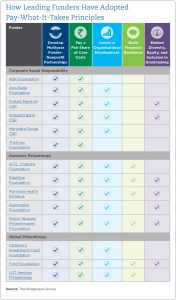Chronic underfunding of nonprofits’ ‘true costs’– programme expenses, core administrative expenditures, organisational development investments, plus reserve funding – blunts the impact funders and nonprofits strive for. As a result, neither party lives up to its aspirations for beneficial change, while those served miss out on opportunities.
The Pay-What-It-Takes (PWIT) India Initiative, launched in 2020, is a collaborative effort to seek sector-level solutions for this problem and has identified five principles that funders can adopt to build stronger, more effective nonprofits.[1] Our latest report for the PWIT Initiative describes how 14 funders, including corporate social responsibility (CSR) organisations, have pursued one or more of the principles. We cite representative examples below.
Develop Multiyear Funder-Nonprofit Partnerships
Multiyear partnerships nurture trust as relationships deepen over time and as mutual understanding of a nonprofit’s needs and goals grows. Such partnerships allow nonprofits to plan and implement programmes and pursue new or more effective approaches that require sustained effort and a long-term funding commitment.
Our research revealed several ways in which funders form such partnerships. They varied from starting the relationship with a pilot or learning grants (e.g., LGT Venture Philanthropy), to committing to long-term support after a thorough due diligence, to assessing values alignment (e.g., Rainmatter Foundation).
Pay a Fair Share of Core Costs
 Core costs – often referred to as indirect costs – are a nonprofit’s shared administrative expenses essential for running operations effectively to deliver impact (e.g., rent and utilities, technology, and fundraising). Our analysis of 40 leading, relatively well-funded nonprofits revealed the extent of underfunding of these critical costs. While the actual core costs of nonprofits averaged 19 percent (and ranged from 5 percent to 51 percent depending on variety of factors), funders typically provided only an average of 9 percent. Several of the funders we profiled recognize this issue and have adopted approaches for providing fuller cost coverage.
Core costs – often referred to as indirect costs – are a nonprofit’s shared administrative expenses essential for running operations effectively to deliver impact (e.g., rent and utilities, technology, and fundraising). Our analysis of 40 leading, relatively well-funded nonprofits revealed the extent of underfunding of these critical costs. While the actual core costs of nonprofits averaged 19 percent (and ranged from 5 percent to 51 percent depending on variety of factors), funders typically provided only an average of 9 percent. Several of the funders we profiled recognize this issue and have adopted approaches for providing fuller cost coverage.
Axis Bank Foundation provides need-based core cost funding by not defining any upper limit. Funders like ASK Foundation may have a predetermined upper threshold but are flexible in meeting actual need. Another approach, adopted by Mahindra Group CSR and Thermax Foundation, provides nonprofits with the flexibility to use funds across budget line items, including core costs, as needed.
Invest in Organisational Development
Organisational development (OD) investments build and strengthen a range of critical capabilities, such as strategic planning and leadership development, that enable nonprofits to raise their impact over time. Our research shows that nonprofits investing in OD grew their annual budgets twice as fast over a five-year period compared to other nonprofits. Other research also suggests that OD helps NGO improve their programme output and financial resilience.
Our funder cohort pursues a number of approaches to supporting grantee organizational development. A.T.E. Chandra Foundation and the Children’s Investment Fund Foundation (CIFF) make dedicated OD grants in addition to providing programme funding. Forbes Marshall CSR and IndusInd Bank CSR make OD a percentage of total funding. Some funders also bring in expert advisors or volunteers to support grantees’ organizational development.
Build Financial Resilience
Financial resilience refers to a nonprofit’s ability to sustain its operations over the long term and withstand external stresses and shocks. Developing prudent financial plans, monitoring financial performance, diversifying the funder base, and growing reserve funds help nonprofits improve long-term stability.
Yet, our research indicates that just nine percent of funders provided direct support for building nonprofits’ reserves (corpus). This is partly due to legal barriers, like CSR rules, which restrict corporate funders from contributing to reserves. However, domestic foundations and high-net-worth individuals face no such barriers. The Rohini Nilekani Philanthropies and Azim Premji Foundation are helping grantees build their reserves, charting the way for others to follow.
Embed Diversity, Equity, and Inclusion in Grantmaking
Many countries have a long history of systemic inequities based on caste, race, gender, tribal origin, and religion. Paying careful attention to diversity, equity, and inclusion (DEI) considerations can identify and address inequity, and help nonprofits take into account the distinctive strengths and needs of diverse, historically marginalised communities.
While our engagement with funders indicated that they have a significant distance to travel on DEI, there are emerging practices. For example, funders like IndusInd Bank, EdelGive Foundation, and Rohini Nilekani Philanthropies have integrated DEI principles in their grant making processes. CIFF and the Bill and Melinda Gates Foundation have adopted accountability towards DEI through public statements and surveys of grantees.
****
Chronic underfunding is a complex issue, and all stakeholders need to work together to solve it. But funders hold the purse strings, which puts responsibility for leadership in their court. For their part, nonprofits can be clear about their own true costs, needs for OD, and financial resilience. Transparency helps to create the mutual trust needed for nonprofits and funders to work together more effectively.
The 14 funders we profiled show practical ways to adapt grantmaking practices to invest in strengthening the nonprofit organisations to do their work more effectively. Working together as trusted partners, funders and nonprofits can build a stronger, more effective social sector that delivers a much higher trajectory of social development.
Pritha Venkatachalam is a partner and co-head, Asia and Africa, at The Bridgespan Group in India.
Shashank Rastogi is a partner at The Bridgespan Group in India.
Aditi Sharma is a manager at The Bridgespan Group in India.
[1] The Pay-What-It-Takes India Initiative was seeded by five anchor partners: A.T.E. Chandra Foundation, Children’s Investment Fund Foundation, EdelGive Foundation, Ford Foundation, and Omidyar Network India. Omidyar Network India co-sponsored the initiative only in 2020. In 2023, two other anchor partners joined the initiative: Forbes Marshall and the Bill & Melinda Gates Foundation.
Correction: A previous version of the visual that accompanies this article omitted a fourth check mark for A.T.E. Chandra Foundation





Comments (0)
I want to work with your organisation .
Word games are one of the very hot puzzle game genres. It is very popular. Especially young people. Expand vocabulary with simple to complex puzzles. Definitely won't be bored